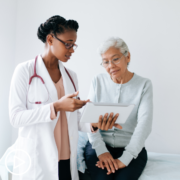What Guidance Can Help Nurses With Clinical Trial Communication?
What Guidance Can Help Nurses With Clinical Trial Communication? from Patient Empowerment Network on Vimeo.
How can healthcare providers aid nurses with clinical trial communication guidance? Expert Dr. Beth Faiman from Taussig Cancer Institute shares her unique perspective and advice as a former nurse practitioner and clinical trials nurse.
Download Resource Guide|Descargar guía de recursos
Related Resources:

|

|

|
Transcript:
Dr. Nicole Rochester:
Dr. Faiman, as we continue on this topic, and as someone who has been a consistent figure in the continuum of care, how do you guide other nursing professionals when it comes to clinical trial communication? Do you have specific tips or tricks or things that you can share with the audience?
Dr. Beth Faiman:
Yeah, absolutely. So I think I have a unique perspective having been a clinical trials nurse, nurse practitioner, and now I conduct, independently, clinical trials. And so I, throughout that whole journey, so I share my experiences and some of the key tips that I like to share with other nurses and healthcare providers is just coming to the patient level. And as Ruthie had said a moment ago, at each encounter you have that opportunity to educate that patient about their labs, what’s their remission status, their disease status, what drugs are they on, what worked, what didn’t work? And the ones that are in remission for a while, one, two, three, five years, we have discussions about next therapy.
So I say to them, “Okay, now, we have a great clinical trial. I think everything’s going very well with your disease remission status, but let’s make sure that you know what might be the next best thing for you.”
And I start planting that seed, giving them information about next therapy so that it’s not that, “Oh my gosh, I thought I was never going to relapse and now I need another treatment.” It’s okay, we have a game plan, we’re here in this together, let’s get some information.
So disseminating this at this critical information to nurses at national conferences about the different drugs that are available, the toxicities, and how to offer them to our patients, I think is really important. But really just cheering in that partnership, as we just talked about, is really key to success, I think.
Share Your Feedback:
Evolving Myeloma Clinical Trial Discussions Amid a Dynamic Treatment Landscape
Evolving Myeloma Clinical Trial Discussions Amid a Dynamic Treatment Landscape from Patient Empowerment Network on Vimeo.
How can discussion about myeloma clinical trials continue to expand? Experts Dr. Beth Faiman from Taussig Cancer Institute and RuthAnn Gordon from Memorial Sloan Kettering Cancer Center discuss how clinical trial communication has changed and some specific points of communication that are helpful.
Download Resource Guide|Descargar guía de recursos
Related Resources:

|

|

|
Transcript:
Dr. Nicole Rochester:
Dr. Faiman, as the myeloma treatment landscape continues to expand thanks to clinical trials, how are clinical trial conversations evolving, and what do you feel should be top of mind?
Dr. Beth Faiman:
That’s an excellent question. Over 20 different drugs are available in various combinations. And so we talked about sequencing very briefly about having patients that have access to clinical trials, making sure they’re not exposed to this class, or maybe they needed to be exposed to this class of drug before they can get drug B, for example. And so sharing mutual information through shared decision-making, again, the patients sharing information and goals of care, the provider and healthcare team mutually sharing information, bring in your social worker or pharmacist, etcetera, and then you can mutually agree on a treatment for the patient. And so that is something we did not have 20 years ago. There were very few effective agents.
I like to remind patients when we provide clinical trial consent forms, that the language is written by lawyers, but it’s intended to protect you. I overemphasize that this is voluntary, and you can withdraw your consent at any time. But I try to go back and highlight why there’s stringent, plus or minus one day, maybe you can’t take off three days to go on a holiday weekend, because we really need to dose this drug on that day and obtain this blood information. So again, having the patients understand what’s involved in the clinical trials and then being able to provide information.
I like to also offer handouts. So the International Myeloma Foundation has clinical trials and diversity handouts. And then another one that I really like is by the FDA that describes the importance of clinical trials. I give that to everybody. So at diagnosis, if you’re on a standard care treatment, you’re not receiving a clinical trial. Everybody that comes into my office that I see for myeloma amyloidosis and related disorders, I would say, “You are a candidate for clinical trial now, but if I or somebody else does not involve you or ask you to participate, then ask us. Just ask us about clinical trials.” I even have a pen that says “Ask me about clinical trials” so that everybody can see it.
Dr. Nicole Rochester:
I love the idea of a pen. Wonderful. Well, let’s move on to how to educate and mentor nursing professionals. Both of you are nursing professionals, and you’ve clearly highlighted in this program so far the importance of the role of nurses in this clinical trial process. So, Ms. Gordon, I’m going to go to you. We know that one significant challenge for some providers is actually initiating conversations about clinical trials and also determining the appropriate timing. Can you speak to whether care variation may pose challenges in community hospital settings, perhaps compared to academic hospitals?
RuthAnn Gordon:
Yeah, absolutely. I think one of the most important things about when to talk to the patient is every time, anytime, right? I think that we should be asking them if they’re interested in clinical trials. If they haven’t been engaged in that, we should be talking to them about, “You know, there’s maybe a chance at some time in our partnership together that we will be talking about clinical trials.” And introducing that up front I think is really important so that we don’t leave clinical trials sort of as a last thought and the patient have that feeling. And I think that for the community setting, that’s one of the things that may be a challenge, is because it is hard to put a patient on a clinical trial and run it from a community setting.
So it’s, how do we give them the support and resources so that it’s not so hard and that they do offer it and talk to their patients as much as possible about it? And I feel like that’s what we need to do more with these partnerships with academic settings, is that we have to give them support so that it’s not so hard, and that that clinical trials first of mind to them when they’re planning care for their patients.
Share Your Feedback:
HCP Strategies for Navigating the Pre-trial Eligibility and Informed Consent Process
HCP Strategies for Navigating the Pre-trial Eligibility and Informed Consent Process from Patient Empowerment Network on Vimeo.
How can myeloma patient communication about clinical trials be improved? Clinical trial nursing director RuthAnn Gordon from Memorial Sloan Kettering Cancer Center discusses clinical trial eligibility determinations and the consent process for patients.
Download Resource Guide|Descargar guía de recursos
Related Resources:

|

|

|
Transcript:
Dr. Nicole Rochester:
Ms. Gordon, you’ve been doing this for a long time. In your experience, what are tried and true strategies that healthcare providers can implement to effectively communicate with their patients about clinical trials when speaking to pretrial eligibility determination and the consent process specifically?
RuthAnn Gordon:
Yeah. Thanks for the question. I think that an important thing whenever we’re talking to our patients is to really understand where they are with understanding and how they learn. So it’s important for us to know what their health literacy is so that we’re making sure that we’re talking in a language that they can understand and using words that are appropriate. And so that’s key. Clinical trials have a lot of comprehensive and complex assessments that are needed for pretrial eligibility, right?
So I think it’s really important to make sure that we are being transparent as to what they can expect. We don’t want them to have surprises later on and then not feel like they want to continue with that process. So I do recommend to my providers and my research nurses, sometimes get out the hard stuff up front. Know if they’re going to be there for 12-hour PKs. Let them know. It shouldn’t be a surprise. And I think that that really helps patients. First, they get involved in the process, they know what to expect, and you can really have more confidence in their adherence.
The other thing is to allow time for the conversations, right? We need to allow time for our patients to ask questions. And the consent process can be lengthy. There’s a lot on the document. Sometimes it’s quite long. So you want to make sure that they’re in a state of mind to have the conversation, that you allow time for questions, and that you make it an exchange between the two of you. It’s a dialogue. It should be.
And you should come with understanding where they’re at; understanding a little bit about what’s going on behind the scenes, right?What’s happening at home is important as you’re talking about pretrial eligibility, as you’re talking about what they can expect on trial, just to get a full picture of them. So I think that those to me are very helpful. Providing take-home information to the patient so they have something to reflect on later is also really important, because they’re not going to grasp everything in that one session. And consenting is like an ongoing process, right? You have one conversation, you probably have 10 more.
Dr. Nicole Rochester:
That is wonderful. Thank you so much for sharing that. And I really appreciate that both of you have highlighted the importance of health literacy, and meeting our patients and families where they are and making sure that they understand, and this idea that it’s a continuum: That there may be multiple conversations that will be necessary.
Share Your Feedback:
Understanding Distinct Barriers to Myeloma Clinical Trial Participation
Understanding Distinct Barriers to Myeloma Clinical Trial Participation from Patient Empowerment Network on Vimeo.
What are some ways for myeloma advancements to be driven forward? Expert Dr. Beth Faiman from Taussig Cancer Institute discusses additional solutions to help research efforts for diverse participation in clinical trials.
Download Resource Guide|Descargar guía de recursos
Related Resources:
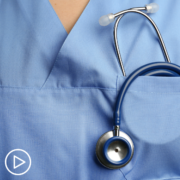
|

|

|
Transcript:
Dr. Nicole Rochester:
Are there any additional solutions that you think are necessary as we continue to see advancements in myeloma?
Dr. Beth Faiman:
Continuing education for these highly trained providers. And so those kind of…the education though, I’ll tell you, I think should focus a lot on the disparities in clinical research. One of the things I’m passionate about is highlighting the implicit and explicit biases that are in clinical research. Many of us will say, “Oh, that person won’t be a good clinical trial candidate because they live too far away or they don’t have a caregiver.” And so I’m really…I tell all of my nurses, nurse practitioners, even physicians, just ask a patient. Don’t think that because they live an hour away, they’re not going to want to participate in a well-designed clinical trial without even asking them. That doesn’t even allow them the opportunity to provide feedback.
And then not to mention all of the resources that are available to patients that provide, that participate in clinical trials. Many of the research studies will provide transportation or an overnight stay or some nominal, again, not trying to coerce the patients, but some nominal reimbursement for expenses to allow them to have access to that drug. So I can talk on and on, because I’m so passionate about this topic. But being aware that biases exist, through continuing education will hopefully enhance the diversity of clinical trials so that patients will be able to have access to care, and then that the clinical trial results are representative of the actual population of who we’re treating.
Dr. Nicole Rochester:
Thank you. I can definitely feel they’re both of your passion, and that’s why it’s so important that we have you here with us today for this conversation. So let’s shift focus a little bit and begin to talk about communication between healthcare providers to effectively communicate about pretrial eligibility determination and the consent process. So I’m going to go right back to you, Dr. Faiman. What do you think are the unique barriers that providers face when they’re speaking about myeloma trials to patients and their families?
Dr. Beth Faiman:
Right. So I think multiple myeloma is unique in that there is such an explosion of new therapies within the last decade. There hasn’t been such momentum in any other cancer such as multiple myeloma. But, unfortunately, there are challenges such as language barriers and communication problems that overarching with all the different specialties. The geographic I had already mentioned in a previous discussion about the geographic barriers to participate in clinical trials, not meeting inclusion criteria, I think it takes an astute nurse or advanced practice provider or physician to now sequence the therapy.
So for example, they have new therapies such as BCMA-targeted drugs that are available through cellular therapy trials or bispecific antibody trials. And without getting too specific into the drugs, you need a specialist to be able to say, “Okay, if I give you this drug today, that will exclude you from a clinical trial that might be very innovative and promising in the future.”
So those are unique barriers to accessing clinical trials or standard therapies for that matter because of the plethora of therapies that are available. So getting in, having patients get in with a myeloma specialist, they might not see them on a regular basis, maybe employ telehealth techniques, see them once and then virtually connect, share information about what might be available. Those are ways that you can provide access to patients, caregivers, and others throughout their disease trajectory because they’re living longer than ever.
Dr. Nicole Rochester:
Which is a wonderful thing.
Dr. Beth Faiman:
Yes.
Share Your Feedback:
Understanding Unique Barriers Faced by Myeloma Research Nurses
Understanding Unique Barriers Faced by Myeloma Research Nurses from Patient Empowerment Network on Vimeo.
What are some ways that myeloma research nurses overcome barriers? Expert Dr. Beth Faiman from Taussig Cancer Institute explains the vital role that research nurses serve as part of the multidisciplinary team for patients and how they overcome barriers.
Download Resource Guide|Descargar guía de recursos
Related Resources:

|

|

|
Transcript:
Dr. Nicole Rochester:
Dr. Faiman, can you speak to unforeseen or outdated practice-related barriers that may actually hinder the work of research nurses?
Dr. Beth Faiman:
Absolutely. So I want to preface this by saying in my mind. I think that both oncology nurses and advanced practice providers are highly trained professionals that should function within a multidisciplinary team. So that team, just as you mentioned before, Dr. Rochester, was the physician has limited time, maybe even the advanced practice provider has limited time. How can we harness all of our resources to provide the best care to that patient?
And clinical trials are one of them. Clinical trials will offer support so that the patient can have access to a pharmacist, a social worker, a dedicated nurse, a dedicated line to call if they’re having a symptom. But to speak to some of the outdated procedures, again, it goes to scope of the practice. No matter how highly trained they are experientially or with credentialing, there are practice barriers within the hospital organization within state laws.
The nice thing about clinical trials though, is that nurses in most institutions are very able to watch that clinical protocol. They’ll look for who needs to hold a medication because of toxicity, consult with the provider, and then they’ll say, “Okay, hold your dose. And when your toxicity resolves, reduce it one dose level, and come back for labs,” or whatever that would entail. So while there are outdated practices historically, I think that within clinical trials nursing it provides some more autonomy for oncology nurses, again, as a part of that multidisciplinary team to enhance patient care.
Share Your Feedback:
How Do Nurses and Allied Professionals Help in Myeloma Clinical Trial Settings?
How Do Nurses and Allied Professionals Help in Myeloma Clinical Trial Settings? from Patient Empowerment Network on Vimeo.
How are myeloma clinical trials aided by nurses and other patient advocates? Experts Dr. Beth Faiman from Taussig Cancer Institute and RuthAnn Gordon from Memorial Sloan Kettering Cancer Center share how others help with patients considering clinical trials and those in clinical trials.
Download Resource Guide|Descargar guía de recursos
Related Resources:

|

|

|
Transcript:
Dr. Nicole Rochester:
Dr. Faiman, we know that patients with myeloma are living longer, and they’re dealing with a different set of challenges than perhaps they previously encountered. So can you speak to the critical role of nurses specifically in the myeloma trial setting today?
Dr. Beth Faiman:
Yeah, absolutely. You know, I must first start by saying that the successes in the treatment of multiple myeloma can be owed to the brave participation of the patients and the caregivers. So let’s not forget about the caregivers to support the patients with clinical trials. And I started as a clinical trials nurse in the 1990s managing these patients, and a nurse practitioner in 2002. And now my role is different also as a researcher.
And so I have seen firsthand all these drug developments. And so the difference from before when we had very few available therapies to now we have an armamentarium of drugs, and so deciding whether or not to participate in a clinical trial is super important. And how can we support our patients who are now living a longer life span with all these cumulative physical and financial issues? How can the nurses support the patients to get the access to the drugs and access to the financial resources they need so that they continue living a good quality of life? I know we have a very robust program to talk about later on, but I think nurses can fill that critical gap of finding resources for patients to allow them to participate in clinical trials to live a better life.
Dr. Nicole Rochester:
Thank you. Ms. Gordon, we know that diversity in clinical trials is lacking. Certainly there have been lots of reports about that. It’s gotten increasing attention over the last few years. There’s now regulations related to that. And while things are changing, we have a long way to go. And it’s also important that we celebrate the wins that we’ve achieved along the way. So my question for you is, do research nurses play a role in increasing diversity in clinical trials and also in trial innovation?
RuthAnn Gordon:
Absolutely. I think that one of the things that is important is community outreach, right? And so we have a lot of opportunities for research nurses. Well, as in large academic settings, a focus needs to be on exploring ways to have partnerships with our community organizations. And once those connections are established, the research nurses can play an extremely pivotal role in ensuring that we’re not only at point-of-consent educating, but way before that, getting involved in pre-screening activities in order to ensure that we’re looking at a diverse population.
And also to help with providers that are in the community that may have more advanced questions, and having the nurse being partners with those clinicians in order to help them get through the questions that they might have in a more timely manner. And so the research nurses that are attached to those academic centers have a pivotal role in ensuring that the community centers have support.
And in doing the pre-screening, I think is an important feature of having the research nurse also be involved in that process. And so I think that…we know that the community has needs, and we know that we need to increase that access. So looking at opportunities to partner with those settings, to me, with the research nurse, is really critical, and I think is an important way that we can do that.
Educating is, I’ll keep going back to that, when you get hands on that patient, making sure that they understand what they can expect. And any misconceptions. Clearing up misconceptions about being on clinical trials is really important so that when you have a patient that is eligible, that they feel comfortable and confident in joining that study.
Share Your Feedback:
How Do Research Nurses Assist Myeloma Patients on Their Journey?
How Do Research Nurses Assist Myeloma Patients on Their Journey? from Patient Empowerment Network on Vimeo.
Research nurses can help myeloma patients, but how do they help exactly? Clinical trial nursing director RuthAnn Gordon from Memorial Sloan Kettering Cancer Center explains the different ways that research nurses help during the patient journey.
Download Resource Guide|Descargar guía de recursos
Related Resources:

|

|

|
Transcript:
Dr. Nicole Rochester:
We know that research nurses are at the front line of treating patients. Can you speak to your role, and how you believe it has changed over time?
RuthAnn Gordon:
Absolutely. First, I can tell you that I’ve been doing research nursing for over 20 years and really love the work. I think it’s important for patients to have that support when they’re going through a clinical trial. And so we’ve done a lot of work to make sure that they have that support. So our role is to really be able to guide the patient through the journey, making sure that they’re educated on what they can expect on the clinical trial, and not only in terms of what maybe the drug might be doing them in terms of side effects, but what is their schedule going to look like? When are they going to have to come in? How long are they going to be here? What does that mean? And how do we support them with their quality of life while they go through all the responsibilities that they as patients have on a clinical trial, and what do they need to do to get ready for that experience?
And so we’re guiding them, we’re educating them, we’re ensuring that they do understand the potential side effects, but do understand also what their role is in the clinical trial and what they can expect. And I think that in terms of what has changed is that we have really put more value on the fact that having that nurse that has the expertise in the clinical trial and really can gatekeep all of the patient care coordination that that involves from a clinician experience and from a clinician perspective, has really helped to ensure that our patients are ready, that we can do our very complex trials.
Because trials have changed so much in the last decade. There’s so many more expectations. There are so many more things that need to happen while they’re on the trial that really having that clinician doing that with the patient has improved our ability to do those kinds of complex trials. And so I think that really recognizing that having that clinician perspective at the partner, at the bedside with the patient has really helped us to expand the kind of trials that we can do.
Share Your Feedback:
HCP Roundtable: Best Practices for Talking About Clinical Trials With Myeloma Patients
HCP Roundtable: Best Practices for Talking About Clinical Trials With Myeloma Patients from Patient Empowerment Network on Vimeo.
Clinical trials represent tomorrow’s medicine today, yet not every patient confronting a myeloma diagnosis is informed about all available care options. Surprisingly, some patients and their care partners are never introduced to the possibility of participating in clinical trials. How can we alter the course? What strategies can healthcare professionals (HCPs) employ to effectively communicate information about clinical trials and guide patients through next steps?
Experts Dr. Beth Faiman and RuthAnn Gordon share important insights into understanding the critical role of clinical trial nurses and how they educate and mentor nursing professionals around best practices for broaching clinical trial conversations.
Download Resource Guide|Descargar guía de recursos
Related Resources:

|

|

|
Transcript:
Dr. Nicole Rochester:
Welcome to this Empowering Providers to Empower Patients program. I’m Dr. Nicole Rochester, pediatrician and CEO of Your GPS Doc. EPEP is a Patient Empowerment Network program that serves as a secure space for healthcare providers to learn techniques for improving physician-patient communication and overcoming practice barriers. Today we are tackling best practices for talking about clinical trials with myeloma patients. One significant challenge for some providers is initiating conversations about clinical trials and determining the appropriate timing of those conversations.
While clinical trials are often described as embodying tomorrow’s medicine today, not every patient facing a myeloma diagnosis is well-informed about all available care options. Astonishingly, some patients and their care partners are never even introduced to the possibility of participating in clinical trials. How can we shift this trend? How do we make these conversations a standard part of healthcare discussions at the outset of care?
What strategies can we as healthcare professionals employ to effectively convey information about clinical trials and guide patients and families through the next steps? We are joined today by RuthAnn Gordon, Director of Clinical Trial Nursing at Memorial Sloan Kettering. Ms. Gordon oversees clinical trial nurses, and develops and implements policies, procedures, standards, and systems to improve quality and compliance in the conduct of clinical research. We are also joined by Dr. Beth Faiman, a nurse practitioner and research oncology professional at the Cleveland Clinic. Dr. Faiman is an active author, presenter, and educator on the topic of multiple myeloma. Thank you both for joining me for this very important conversation.
Dr. Beth Faiman:
Thank you for having us.
Dr. Nicole Rochester: So we have a lot to discuss as it relates to best practices for talking about clinical trials with myeloma patients and their families. And I think this is always a topic that deserves so much conversation, likely more than we will be able to dedicate today. And while it can be a broadly beneficial conversation to have, in the program today we are speaking to the unique needs of myeloma patients and their families.
Some of the topics we’ll tackle today are understanding the critical role of clinical trial nurses, healthcare provider to healthcare provider recommended strategies to effectively communicate about pretrial eligibility determination and the consenting process, and how to educate and mentor nursing professionals in community hospital settings and beyond, guiding them to assist patients and families through the subsequent steps of participating in a clinical trial.
So let’s get started by talking about the role of clinical trial nurses. And, Ms. Gordon, I’m going to start with you. We know that research nurses are at the front line of treating patients. Can you speak to your role, and how you believe it has changed over time?
RuthAnn Gordon:
Absolutely. First, I can tell you that I’ve been doing research nursing for over 20 years and really love the work. I think it’s important for patients to have that support when they’re going through a clinical trial. And so we’ve done a lot of work to make sure that they have that support. So our role is to really be able to guide the patient through the journey, making sure that they’re educated on what they can expect on the clinical trial, and not only in terms of what maybe the drug might be doing them in terms of side effects, but what is their schedule going to look like? When are they going to have to come in? How long are they going to be here? What does that mean? And how do we support them with their quality of life while they go through all the responsibilities that they as patients have on a clinical trial, and what do they need to do to get ready for that experience?
And so we’re guiding them, we’re educating them, we’re ensuring that they do understand the potential side effects, but do understand also what their role is in the clinical trial and what they can expect. And I think that in terms of what has changed is that we have really put more value on the fact that having that nurse that has the expertise in the clinical trial and really can gate keep all of the patient care coordination that that involves from a clinician experience and from a clinician perspective, has really helped to ensure that our patients are ready, that we can do our very complex trials. Because trials have changed so much in the last decade.
There’s so many more expectations. There’s so many more things that need to happen while they’re on the trial that really having that clinician doing that with the patient has improved our ability to do those kinds of complex trials. And so I think that really recognizing that having that clinician perspective at the partner, at the bedside with the patient has really helped us to expand the kind of trials that we can do.
Dr. Nicole Rochester:
Thank you. And as a physician who acknowledges that the time that we are allotted with our patients is often very little, it really makes a lot of sense that you all are able to bridge those gaps in the patient education, and are critically important to this work. So thank you for the work that you do. Dr. Faiman, we know that patients with myeloma are living longer, and they’re dealing with a different set of challenges than perhaps they previously encountered. So can you speak to the critical role of nurses specifically in the myeloma trial setting today?
Dr. Beth Faiman:
Yeah, absolutely. You know, I must first start by saying that the successes in the treatment of multiple myeloma can be owed to the brave participation of the patients and the caregivers. So let’s not forget about the caregivers to support the patients with clinical trials. And I started as a clinical trials nurse in the 1990s managing these patients, and a nurse practitioner in 2002. And now my role is different also as a researcher. And so I have seen firsthand all these drug developments. And so the difference from before when we had very few available therapies to now we have an armamentarium of drugs, and so deciding whether or not to participate in a clinical trial is super important. And how can we support our patients who are now living a longer lifespan with all these cumulative physical and financial issues? How can the nurses support the patients to get the access to the drugs and access to the financial resources they need so that they continue living a good quality of life? I know we have a very robust program to talk about later on, but I think nurses can fill that critical gap of finding resources for patients to allow them to participate in clinical trials to live a better life.
Dr. Nicole Rochester:
Thank you. And thank you for acknowledging the role of the patients and their caregivers in all of the growth that we’ve seen in this field, in the research. Ms. Gordon, we know that diversity in clinical trials is lacking. Certainly there have been lots of reports about that. It’s gotten increasing attention over the last few years. There’s now regulations related to that. And while things are changing, we have a long way to go. And it’s also important that we celebrate the wins that we’ve achieved along the way. So my question for you is, do research nurses play a role in increasing diversity in clinical trials and also in trial innovation?
RuthAnn Gordon:
Absolutely. Absolutely. I think that one of the things that is important is community outreach, right? And so we have a lot of opportunities for research nurses. Well, as in large academic settings, a focus needs to be on exploring ways to have partnerships with our community organizations. And once those connections are established, the research nurses can play an extremely pivotal role in ensuring that we’re not only at point-of-consent educating, but way before that, getting involved in pre-screening activities in order to ensure that we’re looking at a diverse population.
And also to help with providers that are in the community that may have more advanced questions, and having the nurse being partners with those clinicians in order to help them get through the questions that they might have in a more timely manner. And so the research nurses that are attached to those academic centers have a pivotal role in ensuring that the community centers have support.
And in doing the pre-screening, I think is an important feature of having the research nurse also be involved in that process. And so I think that…we know that the community has needs, and we know that we need to increase that access. So looking at opportunities to partner with those settings, to me, with the research nurse, is really critical, and I think is an important way that we can do that.
Educating is, I’ll keep going back to that, when you get hands on that patient, making sure that they understand what they can expect. And any misconceptions. Clearing up misconceptions about being on clinical trials is really important so that when you have a patient that is eligible, that they feel comfortable and confident in joining that study.
Dr. Nicole Rochester:
Wonderful. Thank you so much. Dr. Faiman, I’m going to come back to you. And my question for you is, can you speak to unforeseen or outdated practice-related barriers that may actually hinder the work of research nurses?
Dr. Beth Faiman:
Absolutely. So I wanna preface this by saying in my mind. I think that both oncology nurses and advanced practice providers are highly trained professionals that should function within a multidisciplinary team. So that team, just as you mentioned before, Dr. Rochester, was the physician has limited time, maybe even the advanced practice provider has limited time. How can we harness all of our resources to provide the best care to that patient? And clinical trials are one of them. Clinical trials will offer support so that the patient can have access to a pharmacist, a social worker, a dedicated nurse, a dedicated line to call if they’re having a symptom. But to speak to some of the outdated procedures, again, it goes to scope of the practice. No matter how highly trained they are experientially or with credentialing, there are practice barriers within the hospital organization within state laws.
The nice thing about clinical trials though, is that nurses in most institutions are very able to watch that clinical protocol. They’ll look for who needs to hold a medication because of toxicity, consult with the provider, and then they’ll say, “Okay, hold your dose. And when your toxicity resolves, reduce it one dose level, and come back for labs,” or whatever that would entail. So while there are outdated practices historically, I think that within clinical trials nursing it provides some more autonomy for oncology nurses, again, as a part of that multidisciplinary team to enhance patient care.
Dr. Nicole Rochester:
That’s wonderful. Are there any additional solutions that you think are necessary as we continue to see advancements in myeloma?
Dr. Beth Faiman:
Continuing education for these highly trained providers. And so those kind of…the education though, I’ll tell you, I think should focus a lot on the disparities in clinical research. One of the things I’m passionate about is highlighting the implicit and explicit biases that are in clinical research. Many of us will say, “Oh, that person won’t be a good clinical trial candidate because they live too far away or they don’t have a caregiver.” And so I’m really…I tell all of my nurses, nurse practitioners, even physicians, just ask a patient. Don’t think that because they live an hour away, they’re not going to want to participate in a well-designed clinical trial without even asking them. That doesn’t even allow them the opportunity to provide feedback.
And then not to mention all of the resources that are available to patients that provide, that participate in clinical trials. Many of the research studies will provide transportation or an overnight stay or some nominal, again, not trying to coerce the patients, but some nominal reimbursement for expenses to allow them to have access to that drug. So I can talk on and on, because I’m so passionate about this topic. But being aware that biases exist, through continuing education will hopefully enhance the diversity of clinical trials so that patients will be able to have access to care, and then that the clinical trial results are representative of the actual population of who we’re treating.
Dr. Nicole Rochester:
Thank you. I can definitely feel they’re both of your passion, and that’s why it’s so important that we have you here with us today for this conversation. So let’s shift focus a little bit and begin to talk about communication between healthcare providers to effectively communicate about pretrial eligibility determination and the consent process. So I’m going to go right back to you, Dr. Faiman. What do you think are the unique barriers that providers face when they’re speaking about myeloma trials to patients and their families?
Dr. Beth Faiman:
Right. So I think multiple myeloma is unique in that there are such an explosion of new therapies within the last decade. There hasn’t been such momentum in any other cancer such as multiple myeloma. But, unfortunately, there are challenges such as language barriers and communication problems that overarching with all the different specialties. The geographic I had already mentioned in a previous discussion about the geographic barriers to participate in clinical trials, not meeting inclusion criteria, I think it takes an astute nurse or advanced practice provider or physician to now sequence the therapy.
So for example, they have new therapies such as BCMA-targeted drugs that are available through cellular therapy trials or bispecific antibody trials. And without getting too specific into the drugs, you need a specialist to be able to say, “Okay, if I give you this drug today, that will exclude you from a clinical trial that might be very innovative and promising in the future.”
So those are unique barriers to accessing clinical trials or standard therapies for that matter because of the plethora of therapies that are available. So getting in, having patients get in with a myeloma specialist, they might not see them on a regular basis, maybe employ telehealth techniques, see them once and then virtually connect, share information about what might be available. Those are ways that you can provide access to patients, caregivers, and others throughout their disease trajectory because they’re living longer than ever.
Dr. Nicole Rochester:
Which is a wonderful thing.
Dr. Beth Faiman:
Yes.
Dr. Nicole Rochester:
Ms. Gordon, you’ve been doing this for a long time. In your experience, what are tried and true strategies that healthcare providers can implement to effectively communicate with their patients about clinical trials when speaking to pretrial eligibility determination and the consent process specifically?
RuthAnn Gordon:
Yeah. Thanks for the question. I think that an important thing whenever we’re talking to our patients is to really understand where they are with understanding and how they learn. So it’s important for us to know what their health literacy is so that we’re making sure that we’re talking in a language that they can understand and using words that are appropriate. And so that’s key. Clinical trials have a lot of comprehensive and complex assessments that are needed for pretrial eligibility, right?
So I think it’s really important to make sure that we are being transparent as to what they can expect. We don’t want them to have surprises later on and then not feel like they want to continue with that process. So I do recommend to my providers and my research nurses, sometimes get out the hard stuff up front. Know if they’re going to be there for 12-hour PKs. Let them know. It shouldn’t be a surprise. And I think that that really helps patients. First, they get involved in the process, they know what to expect, and you can really have more confidence in their adherence.
The other thing is to allow time for the conversations, right? We need to allow time for our patients to ask questions. And the consent process can be lengthy. There’s a lot on the document. Sometimes it’s quite long. So you wanna make sure that they’re in a state of mind to have the conversation, that you allow time for questions, and that you make it an exchange between the two of you. It’s a dialogue. It should be. And you should come with understanding where they’re at; understanding a little bit about what’s going on behind the scenes, right? What’s happening at home is important as you’re talking about pretrial eligibility, as you’re talking about what they can expect on trial, just to get a full picture of them.
So I think that those to me are very helpful. Providing take-home information to the patient so they have something to reflect on later is also really important, because they’re not going to grasp everything in that one session. And consenting is like an ongoing process, right? You have one conversation, you probably have 10 more.
Dr. Nicole Rochester:
That is wonderful. Thank you so much for sharing that. And I really appreciate that both of you have highlighted the importance of health literacy, and meeting our patients and families where they are and making sure that they understand, and this idea that it’s a continuum: That there may be multiple conversations that will be necessary. Dr. Faiman, as the myeloma treatment landscape continues to expand thanks to clinical trials, how are clinical trial conversations evolving, and what do you feel should be top of mind?
Dr. Beth Faiman:
That’s an excellent question. Over 20 different drugs are available in various combinations. And so we talked about sequencing very briefly about having patients that have access to clinical trials, making sure they’re not exposed to this class, or maybe they needed to be exposed to this class of drug before they can get drug B, for example. And so sharing mutual information through shared decision-making, again, the patients sharing information and goals of care, the provider and healthcare team mutually sharing information, bring in your social worker or pharmacist, etcetera, and then you can mutually agree on a treatment for the patient. And so that is something we did not have 20 years ago. There were very few effective agents.
I like to remind patients when we provide clinical trial consent forms, that the language is written by lawyers, but it’s intended to protect you. I overemphasize that this is voluntary, and you can withdraw your consent at any time. But I try to go back and highlight why there’s stringent, plus or minus one day, maybe you can’t take off three days to go on a holiday weekend, because we really need to dose this drug on that day and obtain this blood information. So again, having the patients understand what’s involved in the clinical trials and then being able to provide information.
I like to also offer handouts. So the International Myeloma Foundation has clinical trials and diversity handouts. And then another one that I really like is by the FDA that describes the importance of clinical trials. I give that to everybody. So at diagnosis, if you’re on a standard care treatment, you’re not receiving a clinical trial. Everybody that comes into my office that I see for myeloma amyloidosis and related disorders, I would say, “You are a candidate for clinical trial now, but if I or somebody else does not involve you or ask you to participate, then ask us. Just ask us about clinical trials.” I even have a pen that says “Ask me about clinical trials” so that everybody can see it.
Dr. Nicole Rochester:
I love the idea of a pen. Wonderful. Well, let’s move on to how to educate and mentor nursing professionals. Both of you are nursing professionals, and you’ve clearly highlighted in this program so far the importance of the role of nurses in this clinical trial process. So, Ms. Gordon, I’m going to go to you. We know that one significant challenge for some providers is actually initiating conversations about clinical trials and also determining the appropriate timing. Can you speak to whether care variation may pose challenges in community hospital settings, perhaps compared to academic hospitals?
RuthAnn Gordon:
Yeah, absolutely. I think one of the most important things about when to talk to the patient is every time, anytime, right? I think that we should be asking them if they’re interested in clinical trials. If they haven’t been engaged in that, we should be talking to them about, “You know, there’s maybe a chance at some time in our partnership together that we will be talking about clinical trials.” And introducing that up front I think is really important so that we don’t leave clinical trials sort of as a last thought and the patient have that feeling.
And I think that for the community setting, that’s one of the things that may be a challenge, is because it is hard to put a patient on a clinical trial and run it from a community setting. So it’s, how do we give them the support and resources so that it’s not so hard and that they do offer it and talk to their patients as much as possible about it? And I feel like that’s what we need to do more with these partnerships with academic settings, is that we have to give them support so that it’s not so hard, and that that clinical trials first of mind to them when they’re planning care for their patients.
Dr. Nicole Rochester:
I see a theme here: Partnership, collaboration. Dr. Faiman, as we continue on this topic, and as someone who has been a consistent figure in the continuum of care, how do you guide other nursing professionals when it comes to clinical trial communication? Do you have specific tips or tricks or things that you can share with the audience?
Dr. Beth Faiman:
Yeah, absolutely. So I think I have a unique perspective having been a clinical trials nurse, nurse practitioner, and now I conduct, independently, clinical trials. And so I, throughout that whole journey, so I share my experiences and some of the key tips that I like to share with other nurses and healthcare providers is just coming to the patient level. And as Ruthie had said a moment ago, at each encounter you have that opportunity to educate that patient about their labs, what’s their remission status, their disease status, what drugs are they on, what worked, what didn’t work? And the ones that are in remission for a while, one, two, three, five years, we have discussions about next therapy. So I say to them, “Okay, now, we have a great clinical trial. I think everything’s going very well with your disease remission status, but let’s make sure that you know what might be the next best thing for you.”
And I start planting that seed, giving them information about next therapy so that it’s not that, “Oh my gosh, I thought I was never going to relapse and now I need another treatment.” It’s okay, we have a game plan, we’re here in this together, let’s get some information. So disseminating this at this critical information to nurses at national conferences about the different drugs that are available, the toxicities, and how to offer them to our patients, I think is really important. But really just cheering in that partnership, as we just talked about, is really key to success, I think.
Dr. Nicole Rochester:
Great. Well, it’s time to wrap up our roundtable. And I have truly enjoyed this conversation. I have personally learned a lot. I’m sure that our audience will learn a lot as well. So I’d like to get closing thoughts from each of you. So I’ll start with you, Ms. Gordon. What is the most important takeaway message that you wanna leave with other healthcare professionals who may be watching?
RuthAnn Gordon:
Thank you. First, thank you for having me at this. This has been an amazing experience, and I want the providers out there to not be afraid of clinical trials, to look at opportunities to work with nurses to help support you in those clinical trials, to have the conversations with your patients early and often, and to work with your community partners.
Dr. Nicole Rochester:
And thank you. Thank you, Ms. Gordon. What about you, Dr. Faiman?
Dr. Beth Faiman:
Well, I guess I would say never underestimate for the nurses, nurse practitioners, physician assistants, social workers, physicians, anyone on the healthcare team. Never underestimate the unique role that you enact in the care of patients with myeloma or other disorders. Use your voice to speak up. If you think a patient is a candidate for a clinical trial but that physician or other provider hasn’t recommended it to them, then tell them why. You can refer them yourself as well. Ask patients about barriers to participation. Is it physical, financial, social? You can’t take time off of work. And then provide that assistance in counseling. It takes a big effort to support our patients, but we would’ve never gotten to where we are with treatment of multiple myeloma in 2024 without patient participation in clinical trials. So whatever we can do to enhance diversity, minimize bias, and support our patients, please try to do the best to do your part.
Dr. Nicole Rochester:
Well, thank you both, Ms. Gordon, Dr. Faiman, for this awesome conversation. We have learned a lot about how we got to where we are with myeloma. And thank you again for pointing out early on, it’s the patients and their caregivers and their participation in clinical trials that has led to the landscape where we are now with so many drugs available. And that really highlights the importance of clinical trials. We talked about diversity of clinical trials.
We talked about the implicit and explicit biases that all of us have, and that sometimes may preclude us from recommending trials for patients that can benefit from this therapy. And we’ve talked about the importance of having these conversations, not once, not twice, but every time that you are in the presence of a patient and their family. And also just the partnership and the collaboration that has already taken place, and that we hope to continue to foster as we move forward. So thank you both again, and thank you all for tuning in to this Empowering Providers to Empower Patients Program. I’m Dr. Nicole Rochester.
Share Your Feedback:
Empowering Providers to Empower Lung Cancer Patients
Empowering patients is at the heart of efforts at Patient Empowerment Network (PEN), and work toward reducing health disparities is part of conversations among healthcare professionals. Precision medicine and the use of biomarker testing is one area of interest in efforts to eliminate healthcare disparities.
With this in mind, PEN has taken on a new initiative, the Empowering Providers to Empower Patients (EPEP) initiative. Starting in lung cancer, the program expands PEN’s reach to healthcare professionals with the goal of improving physician-patient communication; shared decision-making; and the role that lung cancer patients, survivors, care partners, and healthcare professionals each play in the shared decision-making process.
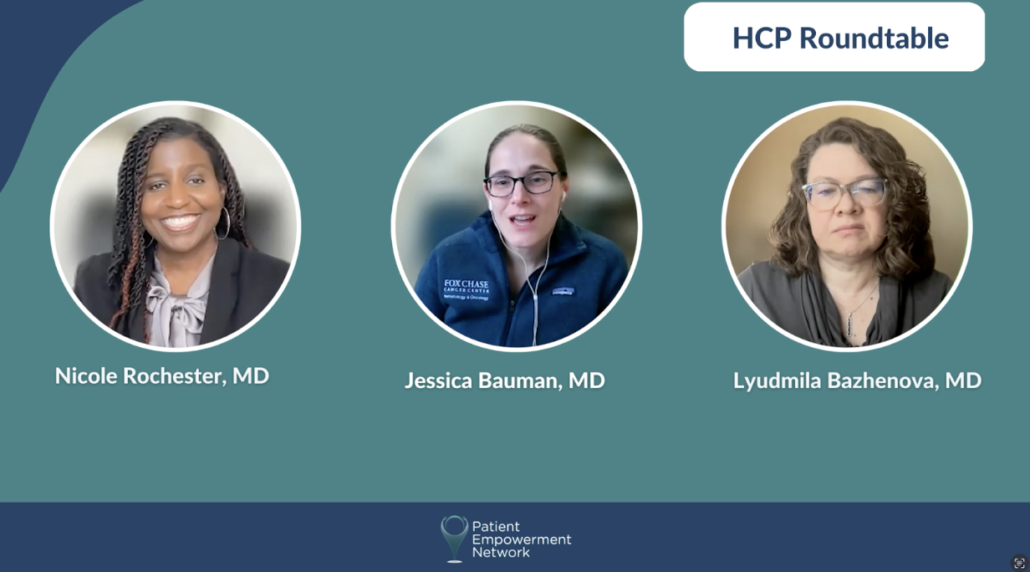
The EPEP initiative includes the following resources:
- Needs Assessment outlines key factors that enable patient empowerment, attributes of an empowered patient, and advice for healthcare professionals to perform a needs assessment for each patient.
- EPEP Roundtables with lung cancer experts Dr. Heather Wakelee, Dr. Lyudmila Bazhenova, Dr. Leigh Boehmer and Dr. Jessica Bauman as they discuss a range of topics including ways to improve physician-patient communication, learnings from tumor boards, collaboration between academic and community oncologists, biomarker testing, and addressing barriers to biomarker testing.
- EPEP Vignettes where lung cancer clinician Dr. Jhanelle Gray from Moffitt Cancer Center shares her experience in biomarker testing, personalized combination therapeutics, and best practices in treating and empowering patients toward more equitable and culturally sensitive care.
- EPEP Biomarker Testing Resource Guide that covers benefits of biomarker testing, when to test, dos and don’ts of biomarker testing, perspectives from a patient and a clinician, and resources for patients.
- EPEP Portal utilizes PEN’s robust resource library and that of numerous trusted advocacy partners to create a vetted list of patient education resources. PEN delivers a curated PDF according to your interests and delivers it efficiently to your inbox.
- Infographics that address the differences between cultural competence versus cultural humility and key steps to work toward practicing cultural humility to help empower your patients in their lung cancer care.
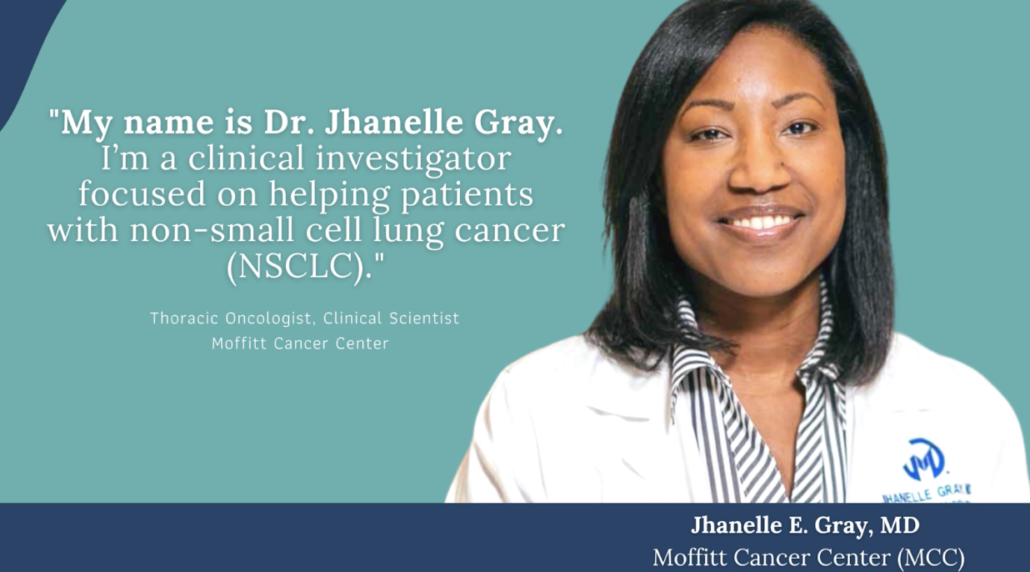
Key Takeaways to Help Empower Lung Cancer Patients
PEN had the opportunity to interview experts Dr. Jhanelle Gray, Dr. Heather Wakelee, and Dr. Leigh Boehmer to learn about some of their expertise. They shared their perspectives about vital ways that they work with patients to help empower them and to work toward the best personalized care for each patient.
Dr. Boehmer shared the importance of biomarker testing to identify driver mutations, “…more than half of patients who’ve developed lung cancer who have never smoked or have a light smoking history are going to have an actionable driving mutation, and even in people who do have a smoking history, of any ethnic background, they’re still 10 to 20 percent or maybe more as we identify more of these driver mutations, where that’s what’s really the force in the tumor.
And if you find it and you can start someone on the appropriate targeted therapy, usually across multiple trials, the toxicity is less than you would get with chemotherapy or immunotherapy…the probability of response is over half, you know, if someone’s going to have a benefit that that’s going to help them feel better for a period of time in controlling their cancer, it really drastically changes their whole tumor outcome, they’re going to be living longer, feeling better, and ultimately that’s our goal when we’re helping someone with metastatic disease…You have to have the physician aware of the importance of finding the mutation, altering the treatment as necessary, and giving that patient the best possible option for care.”
Dr. Gray and Dr. Boehmer also have preferred medical terms when they explain to their patients about biomarker testing. Dr. Gray prefers to steer away from terms that have to do with genomics or genetics and uses the terms “biomarker testing” or “comprehensive biomarker testing” instead. While Dr. Boehmer shares, “I think that’s really important that people always remember to talk about the tumor and not about the mutation in the person, that’s really, really critical.”
Physician Best Practices for Biomarker Testing
With her experience in using biomarker testing in planning personalized combination therapeutics, Dr. Gray shares advice for other healthcare providers. “I think for a provider it is going to be very important when a patient is newly diagnosed with non-small cell lung care especially when they have advanced and later stages as this should be a comprehensive test. This should be a certified assay. I think they should also look at turnaround time for this testing, does the assay include a liquid biopsy portion and a tissue biopsy portion? Is there one that you want to run before the other?
Many times what I will do when I meet a patient initially and they have an advanced or metastatic stage non-small cell lung cancer, I’ll send off the liquid biopsy right then and there, the same day in the hope that I can get the test results back within 7 to 10 days. I will also order the tissue testing. Should the liquid biopsy results from the blood specimen come back sooner, then I can cancel the tissue testing if I feel confident enough in the results. This will then preserve tissue for later analyses. It can also preserve tissue should they need to enroll in an innovative clinical trial and expand their therapeutic options.”
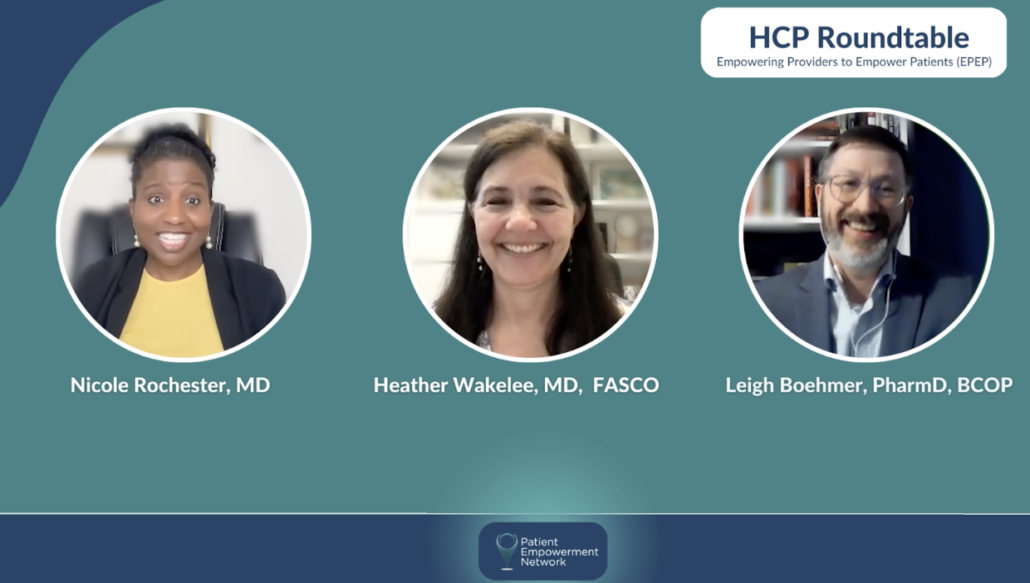
Advocacy for Biomarker Testing
Dr. Wakelee speaks to advocacy for biomarker testing, “…many organizations, including IASLC, including ACCC, including NCCN…I mean, you could name any organization that’s involved in cancer care and education, is really focusing on this issue of making sure that every oncologist knows the importance of doing biomarker testing for patients with non-small cell lung cancer, that we are trying to expand that not just to the oncologist, but also to the folks making the diagnosis, so they can be aware as well…The more people who are aware that’s a standard of care in treating lung cancer, the more that’s going to happen, and then continuing to explore those financial barriers, and as more agents are FDA-approved, where that becomes a preferred first sign option, but you only know that if the testing’s happened, that leads to campaigning to make sure that the testing is being covered as well.”
Dr. Boehmer further explains about the logistics of advocating for biomarker testing. “ACCC…recognizes that a lot of community programs don’t have kind of operational best practices for how to incorporate biomarker testing into a patient’s journey…we’re working on creating care pathways which will help multidisciplinary clinician teams integrate discussions of biomarker testing and its impact at various critical time points along a patient’s diagnosis to treatment, to survivorship or end-of-life care…talking about when and how to have meaningful conversations, and then doing it with health-literate, vetted resources and through a lens of equity and shared decision-making, because you look like me, you had success with it. I’m going to do it for my at-risk patients as well, because one, it’s the right thing to do. And two, you taught me how to do it, and three, you told me what success looks like so I can measure myself against you, and that’s a successful model for scalability.”
And Dr. Gray shares advocacy organizations and ways to move toward biomarker testing equity for all patients. “For those again who are having some difficulty with getting biomarker testing for their patients, I would strongly encourage you to find an advocacy organization such as American Lung Association, LUNGevity, GO2 Foundation, there are many many others out there that are very much interested in improving access to patients with non-small cell lung cancer. This is really a critical area of need and that we really have to drive forward with healthcare equity in this setting…And so, I think putting all this together and coming together as a field is where we can move together and with the patients, the providers, and the advocacy organizations I think that we should all feel empowered to move the needle forward for our patients.”
The bottom line is, while oncologists have more tools to treat lung cancer, access and language remains a big factor in biomarker testing. Comprehensive biomarker testing can play a very important role in the personalized treatment for patients with non-small cell lung cancer (NSCLC), but many questions remain. How do we improve clinician-patient conversations in biomarker testing? And how do we remove barriers that can impede an HCP’s ability to treat patients with personalized care? As the lung cancer field continues to experience tremendous growth in precision medicine, we hope healthcare providers can take advantage of these timely resources of the EPEP initiative to work toward equitable and culturally sensitive care for lung cancer patients.
Empowering MPN Providers to Empower Their Patients
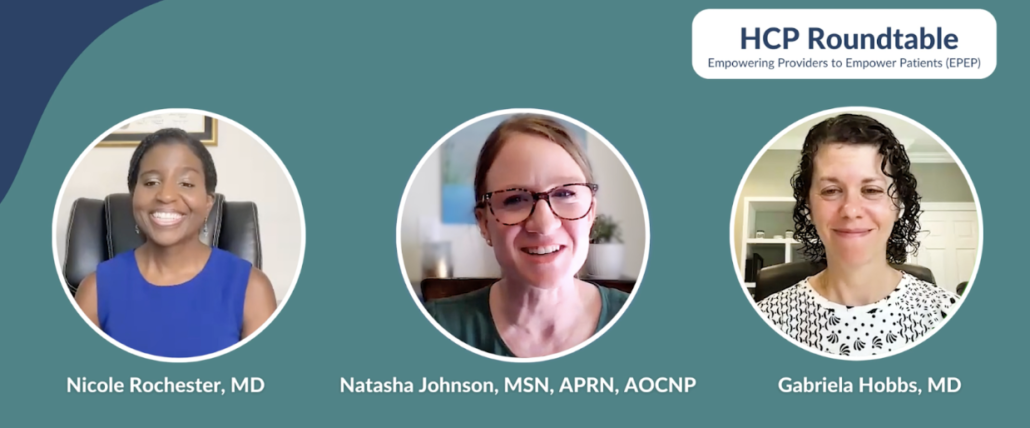
Empowering patients is at the heart of efforts at Patient Empowerment Network (PEN), and work toward reducing health disparities is part of conversations among healthcare professionals. With this in mind, PEN has taken on a new initiative for myeloproliferative neoplasms (MPNs), the MPN Empowering Providers to Empower Patients (EPEP) initiative. The program expands PEN’s reach to healthcare professionals with the goal to improve physician-patient communication; shared decision-making; and the role that MPN patients, survivors, care partners, and healthcare professionals each play in the shared decision-making process.
The EPEP initiative includes the following resources:
- Needs Assessment outlines key factors that enable patient empowerment, attributes of an empowered patient, and advice for healthcare professionals to perform a needs assessment for each patient.
- EPEP Roundtables with Dr. Nicole Rochester and MPN experts Dr. Gabriela Hobbs and Natasha Johnson as they discuss a range of topics including how to help your MPN patients play an active role in managing their care, healthcare provider recommended strategies for managing disease burden, the importance of advanced practice clinicians on the MPN health care team, clinical trials and why it’s vital for nurses to address this topic with patients and families, and cultural humility in action.
- EPEP Resources provides the resource guide, infographics, blog, and other resources to improve patient care
- EPEP Portal utilizes PEN’s robust resource library and that of numerous trusted advocacy partners to create a vetted list of patient education resources. PEN delivers a curated PDF according to your interests efficiently to your inbox.
Key Takeaways to Help Empower MPN Patients
PEN had the opportunity to interview experts Dr. Gabriela Hobbs and Natasha Johnson to learn about some of their expertise. They shared their perspectives about vital ways that they work with patients to help empower them and to work toward the best personalized care for each patient.
The art of listening to patients is an essential part of empowering patients in their care journeys. Expert Dr. Gabriela Hobbs from Massachusetts General Hospital shared her perspective about listening. “…I think knowing where your patient is emotionally, what’s important to them, what are their worries, is really important, so you can have a conversation where you’re not just speaking about the things that you as a provider think is important, but really also listening to where the patient is coming from, and so that you can make sure that you’re appeasing their anxieties and whatever decision you make is consistent with both what you think is medically important, but also with what’s really important for the patients. I think listening is really at the core there.”
Of course, nurse practitioners often serve as valuable members of the MPN care team. As a nurse practitioner, Natasha Johnson shared her perspective in empowering MPN patients. “…I think that we spend a ton of time educating them to make sure that they really understand this disease, the symptoms that go along with it, the treatments that go along with that, and once we have a good confidence that they understand everything, lead them into discussing what their goals of care are, and then we take all that information together, and we create a treatment plan specific to that patient, really aiming to improve their quality of life and overall survival.”
Johnson also shared about the benefits of seeing an MPN specialist. “…I really think there’s a benefit to seeing an MPN expert that is at a national cancer center, academic center. I do think there is some more time allotted to those visits, especially the consults and first appointments for the patient, and we kind of start this with my doctor and other providers of assessing how much does the patient even know to begin with? So that can direct us where to start. And then how deep do they want to go.”
Helping to educate MPN patients, of course, can take a variety of different forms. Johnson explained some of the actions that she takes to help her patients. “…I write a lot of things down for my patients when I see them, I think visuals are really helpful, provide literature, I tell them what websites to visit. A lot of times, they just Google their doctor, which is great because they can find them and listen to their own lectures, and they really learn a lot. So just guiding them to those resources. I do think it’s important, too, to give them something like the total symptom score form. Just having that visual of, these are what is common, and then they can think about that between visits, but I think all of those things really help to educate them and get them involved.”
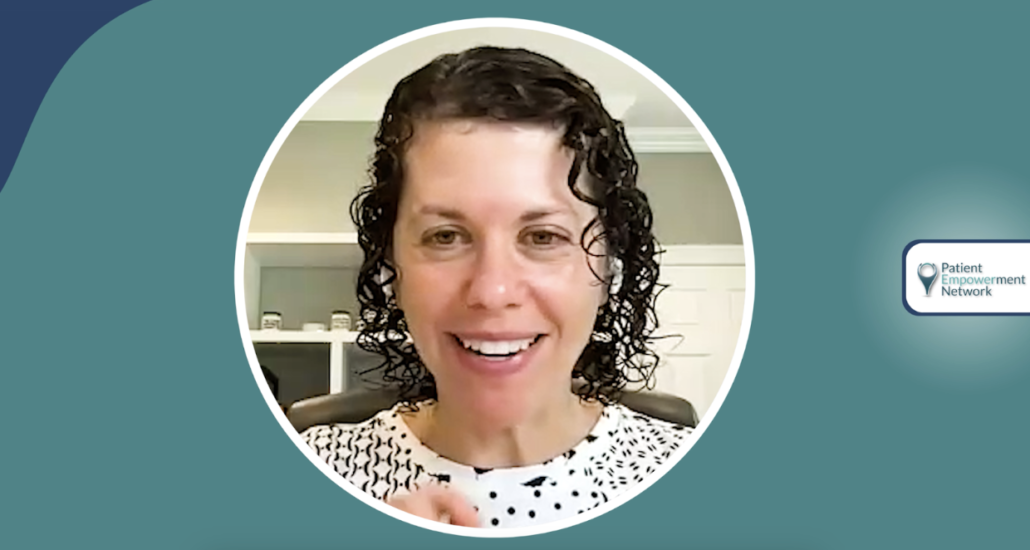
MPN Care Team Best Practices for Patients
Tracking symptoms and preparing for office visits are key tasks for MPN patients. Dr. Hobbs explained how essential these tasks are for patient empowerment. “…for those patients that are very symptomatic, for example, keeping track of their symptoms over time, writing down notes about how they felt, what they think made something better, made something worse, how they’re responding to these medications, questions that they may have, and writing all of that down helps them be more empowered patients. They can advocate for themselves in a more organized way when they do go see either me or another clinician. So they come in fully prepared with the information and the questions that they want to get out of that visit.”
Dr. Hobbs has experienced the value of the symptom assessment form. “I think clinicians are busy and sometimes feel like having a tool to ask those questions is maybe too burdensome. I personally find that the MPN symptom assessment form is a quick form, it’s easy to complete, it can be given to a patient, there’s a piece of paper while they’re waiting for you.”
And Dr. Hobbs shared the benefits she’s experienced with the use of the form. “And that also directs the conversation because it really just gives numbers, makes it objective, and then can really start that conversation. And so remembering that we do have this tool, it actually can help cut down time to the visit and make it more focused, and it’s helpful to…empowers the patient and make sure that you really are asking about all of those symptoms, and just making sure that you don’t just assume that a patient has or doesn’t have a symptom, but really saying, ‘Are there any other symptoms that you’ve noticed?’”
Dr. Hobbs has also witnessed the value of care partners being involved in MPN care conversations about symptoms. “…the spouse is like, ‘But remember, you really haven’t been having your dinner, and remember how you were complaining about how your stomach was hurting every time you ate. And you say you’re not itchy, but every night when we’re watching TV, I turn around and I see that you’re scratching.’ And so I think that’s also a really important tool to make sure that you make use of the family members, because they really know what’s going on if the patient is not willing to share as much or doesn’t like to complain.”

Advocacy for Cultural Humility
Cultural humility is a process of listening and learning about patients. Dr. Hobbs shared her perspective. “…there’s all sorts of history in this country, especially about clinical trials. And I think coming into those encounters, like I said at the beginning of our conversation, taking into account that you really do know your patient. But sometimes, you don’t know the patient as well. You’re getting to know them, and you need to make a decision. Just listening, being humble, being aware, trying to understand where the patient is coming from.”
Dr. Hobbs continued to share about taking this vital time to learn about your patients’ ways of thinking. “I think sometimes, especially when you’re trying to make a decision quickly and you find that there’s some friction, I think taking some time to say, ‘Alright, where is that coming from?’ And perhaps I’m coming across too strong with this recommendation to do this clinical trial and there’s maybe something that I need to explore, and so just keeping an open mind and trying to just ask questions, ‘Where are you coming from? What’s important to you? Why are you hesitating? Or is there something that I can explain in a different way?’”
Even though MPN treatments have experienced increases in quantity and efficacy of treatments, vital HCP best practices can go a long way in empowering MPN patients.How can you help your MPN patients play an active role in managing their care? How do we improve clinician-patient communication about symptoms? How should fellow MPN specialists explain disease progression to patients and care partners? We hope healthcare providers can take advantage of these timely resources of the EPEP initiative to work toward equitable and culturally sensitive care for all MPN patients.
See More from MPN | Empowering Providers to Empower Patients (EPEP)
Explaining Myeloproliferative Neoplasm Disease Progression to Patients
Explaining Myeloproliferative Neoplasm Disease Progression to Patients from Patient Empowerment Network on Vimeo.
What is the best way to explain disease progression to myeloproliferative neoplasm patients? MPN experts Dr. Gabriela Hobbs and Natasha Johnson share advice on how they work with patients and families to clearly explain disease progression.
Dr. Gabriela Hobbs is a hematology-oncology physician specializing in the care of patients with myeloproliferative neoplasms (MPN), chronic myeloid leukemia, and leukemia. Dr. Hobbs serves as clinical director of the adult leukemia service at Massachusetts General Hospital and is an assistant professor at Harvard Medical School.
Natasha Johnson, is an Advanced Oncology Nurse Practitioner at Moffitt Cancer Center, where she cares for people living with MPNs with kindness, patience, and humanity. Natasha also speaks at conferences to educate other healthcare professionals about MPN care, research, and treatment.
See More from Empowering MPN Providers to Empower Patients (EPEP)
Related Resources
Transcript:
Nicole Rochester, MD:
I wanted to shift again and start to talk about specifically disease progression. And we know that that is, unfortunately, something that is an important element of MPNs. And so as we talk to fellow MPN specialists, what are you all’s recommendations for how they can best explain disease progression to patients? Are there any specific languaging or specific tactics that you all use, and even things that maybe you shouldn’t say as you are sharing information about disease progression? Either one of you, feel free to go first.
Gabriela Hobbs, MD:
So disease progression, I think is a really challenging topic, because on the one hand, I think it’s really important to educate patients. It’s really important for patients to know that that is a possibility, that it is something that can happen. It’s really challenging to have a patient that has lived with this disease for a long time, hardly even knows the name of that disease. Maybe they were seen elsewhere, etcetera, and then all of a sudden, something’s going wrong and they just weren’t prepared for that. But I feel like that really does need to be balanced by the fact that, thankfully, progression happens infrequently. And so you also…going back to what we were saying before, you want to help a patient to be able to live well with these diseases and not be defined by those diseases. And so one of the things that I try to do with patients is, especially during that initial visit, I spend some time explaining to them what the disease is, that it can progress to myelofibrosis, that it can progress to leukemia. But then I also try to reassure them as much as possible that this is an infrequent event, that the reason why we follow patients in-clinic is so that we can start to notice if there’s disease progression, that it usually happens gradually.
And then I try to say, “You have this information. We can’t necessarily change that at this moment, there are maybe some tools that we can use in the future, but try to put that information in a box in your brain, put the key, put it away, try not to think about that every day when you’re outside of here. Definitely okay to open that back up when you’re with me in the room. If you want to get those anxieties out, that’s fine, but let’s really try to make sure that that’s in the back and not at the forefront of our thoughts.” And kind of going back to one of the things we were discussing before about what the patient thinks is most important, what the clinician thinks is most important. If you ask patients what are they most concerned about with their MPN, oftentimes that response is, “Is my disease going to progress?” And so I think acknowledging that and talking about that is important, but then also reminding patients that over time, they need to, hopefully with your help, or maybe they need additional assistance with therapists or social workers, etcetera, let’s find a way to put that away so that it’s not really at the forefront of our thoughts every single day, because that also ends up being not productive.
Nicole Rochester, MD:
I love that approach, of providing the education, but also that balance that you talked about, Dr. Hobbs. I love the idea of putting it away, putting it in a box [chuckle] and locking it, and then opening it back up when you’re in the safety with your healthcare provider. That’s beautiful.
Do you have anything to add to that, Ms. Johnson?
Natasha Johnson:
I completely agree. Your example there of putting it in the box, I’m going to use that in clinic. [laughter] I think it’s a great visual for patients. Because like you said, they’re very scared, and it can control them and take over, and we don’t want the disease to take over their life. Still live. Enjoy.
Share Your Feedback:
Create your own user feedback survey

